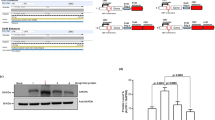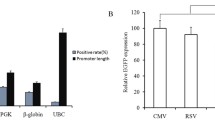Abstract
The 35S cauliflower mosaic virus (CaMV) promoter is commonly used to drive transgene expression in the genetically engineered (GE) crop plants that have been commercialized so far. Whether, and how far, the 35S promoter might be active in mammalian cells has been scientifically unsettled and controversial. Very recently it was established that the 35S promoter is transcriptionally active following transient reporter gene transfections in continuous cell lines of human [J Biotechnol 103:197–202, 2003] and hamster ovary [Environ Biosafety Res 3:41–47, 2004] fibroblasts. The initial exposure of a human organism to DNA from GE food takes place in the gastrointestinal tract (GIT). Hence, we have now investigated the promoter capacity of 35S in human enterocyte-like cells. We constructed expression vectors with 35S promoter inserted in front of two reporter genes encoding firefly luciferase and green fluorescent protein (GFP), respectively, and performed transient transfection experiments in the human enterocyte-like cell line Caco-2. It was demonstrated that the 35S CaMV promoter was able to drive the expression of both reporter genes to significant levels, although the protein expression levels might seem modest compared to those obtained with the strong promoters derived from human cytomegalo virus (hCMV) and simian virus 40 (SV40). Furthermore, computer-based searches of the 35S CaMV DNA sequence for putative mammalian transcription factor binding motifs gave a high number of hits. Some of the identified motifs indicate that transcriptional activation by the 35S CaMV promoter may be stronger in other human and animal cell types than in those investigated so far.





Similar content being viewed by others
References
Pooggin MM, Futterer J, Skryabin KG, Hohn T (2001) Proc Natl Acad Sci USA 98:886–891
Hull R, Covey SN (1983) Sci Prog 68:403–422
Odell JT, Nagy F, Chua NH (1985) Nature 313:810–812
Fromm M, Taylor LP, Walbot V (1985) Proc Natl Acad Sci USA 82:5824–5828
Gasson M, Burke D (2001) Nat Rev Genet 2:217–222
Assaad FF, Signer ER (1990) Mol Gen Genet 223:517–520
Hirt H, Kogl M, Murbacher T, Heberlebors E (1990) Curr Genet 17:473–479
Ruth J, Hirt H, Schweyen RJ (1992) Mol Gen Genet 235:365–372
Gmunder H, Kohli J (1989) Mol Gen Genet 220:95–101
Pobjecky N, Rosenberg GH, nter-Gottlieb G, Kaufer NF (1990) Mol Gen Genet 220:314–316
Ryabova LA, Hohn T (2000) Genes Dev 14:817–829
Ballas N, Broido S, Soreq H, Loyter A (1989) Nucleic Acids Res 17:7891–7903
Vlasak J, Smahel M, Pavlik A, Pavingerova D, Briza J (2003) J Biotechnol 103:197–202
Tepfer M, Gaubert S, Leroux-Coyau M, Prince S, Houdebine LM (2004) Environ Biosafety Res 3:91–97
Fleeton MN, Contractor N, Leon F, Wetzel JD, Dermody TS, Kelsall BL (2004) J Exp Med 200:235–245
Schubbert R, Lettmann C, Doerfler W (1994) Mol Gen Genet 242:495–504
Schubbert R, Renz D, Schmitz B, Doerfler W (1997) Proc Natl Acad Sci USA 94:961–966
Schubbert R, Hohlweg U, Renz D, Doerfler W (1998) Mol Gen Genet 259:569–576
Hohlweg U, Doerfler W (2001) Mol Gen Genomics 265:225–233
Einspanier R, Klotz A, Kraft J, Aulrich K, Poser R, Schwagele F, Jahreis G, Flachowsky G (2001) Eur Food Res Technol 212:129–134
Palka-Santini M, Schwarz-Herzke B, Hosel M, Renz D, Auerochs S, Brondke H, Doerfler W (2003) Mol Genet Genomics 270:201–215
Forsman A, Ushameckis D, Bindra A, Yun Z, Blomberg J (2003) Mol Genet Genomics 270:362–368
Gebert A, Steinmetz I, Fassbender S, Wendlandt KH (2004) Am J Pathol 164:65–72
Jumarie C, Malo C (1991) J Cell Physiol 149:24–33
Fogh J, Fogh JM, Orfeo T (1977) J Natl Cancer Inst 59:221–226
Fogh J, Wright WC, Loveless JD (1977) J Natl Cancer Inst 58:209–214
Pietrzak M, Shillito RD, Hohn T, Potrykus I (1986) Nucleic Acids Res 14:5857–5868
Brussel A, Sonigo P (2003) J Virol 77:10119–10124
Murakami Y, Minami M, Daimon Y, Okanoue T (2004) J Med Virol 72:203–214
Jurka J, Smith T (1988) Proc Natl Acad Sci USA 85:4775–4778
Sonza S, Maerz A, Deacon N, Meanger J, Mills J, Crowe S (1996) J Virol 70:3863–3869
Bradford MM (1976) Anal Biochem 72:248–254
Acknowledgements
M.R.M. and T.T acknowledge financial support from The Research Council of Norway, project no. 129591/310, and also from the Norwegian Ministry of Health.
Author information
Authors and Affiliations
Corresponding author
Rights and permissions
About this article
Cite this article
Myhre, M.R., Fenton, K.A., Eggert, J. et al. The 35S CaMV plant virus promoter is active in human enterocyte-like cells. Eur Food Res Technol 222, 185–193 (2006). https://doi.org/10.1007/s00217-005-0154-3
Received:
Accepted:
Published:
Issue Date:
DOI: https://doi.org/10.1007/s00217-005-0154-3




